The V2X Standards Faceoff
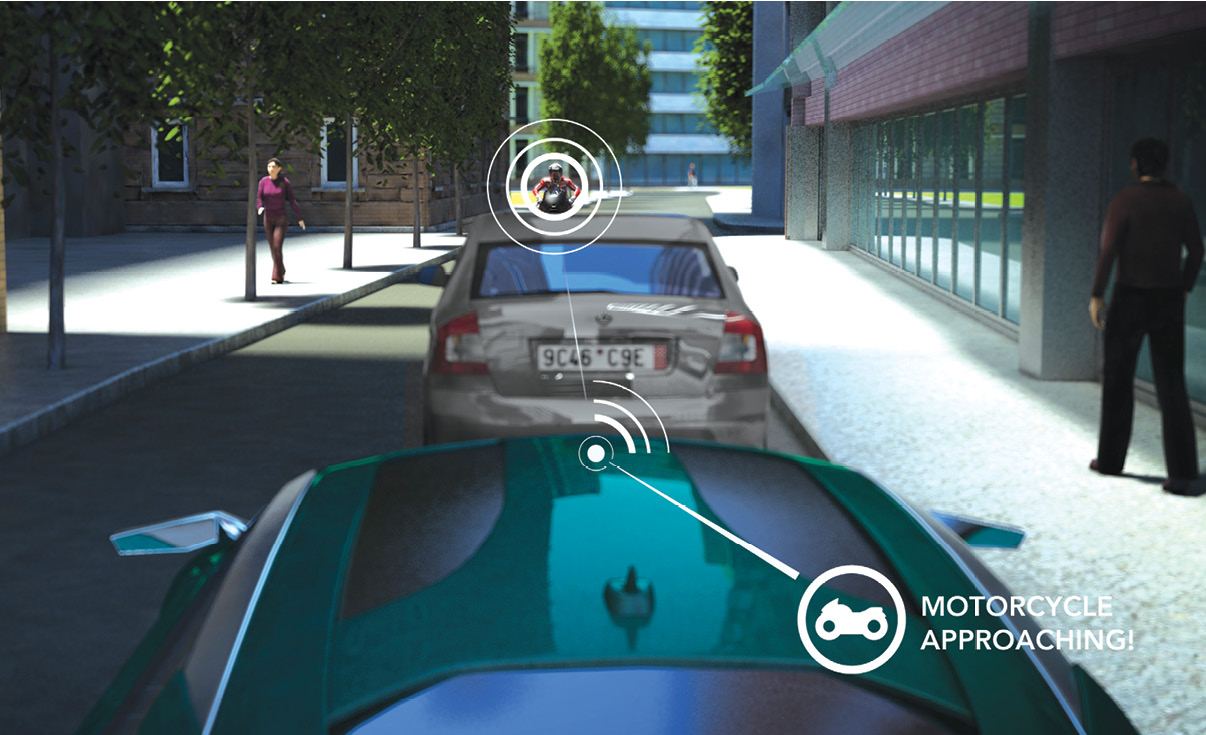
Vehicle-to-everything (V2X) communication promises to enable vehicles, traffic infrastructure and pedestrians, as well as cloud resources, to share information, with the goal of enhancing travel safety and economy. Currently, two technologies are competing for dominance in this arena: dedicated short-range communications (DSRC) and cellular V2X (C-V2X).
September 1, 2018
Many new cars on the market today sport some form of advanced driver-assistance system (ADAS). Leveraging features like backup cameras, automatic braking, lane keeping and blind-spot detection, these systems have proven their ability to significantly enhance driving safety. To take this automotive technology to the next logical level, however, carmakers must add wireless communications. The problem is that the industry cannot agree on a single radio frequency standard to bring the vehicle-to-everything (V2X) communication network to life.
Until recently, the industry and government seemed poised to adopt dedicated short-range communications (DSRC), a technology based on 802.11p, a variant of the Wi-Fi standard. The rise of a cellular technology called C-V2X, however, has caused a pause to consider the strengths and weaknesses of each option before settling on a single wireless standard.
What Is Involved in V2X?
To appreciate the magnitude of the challenge of choosing between the two, consider what V2X is and what the selected communications standard will require.
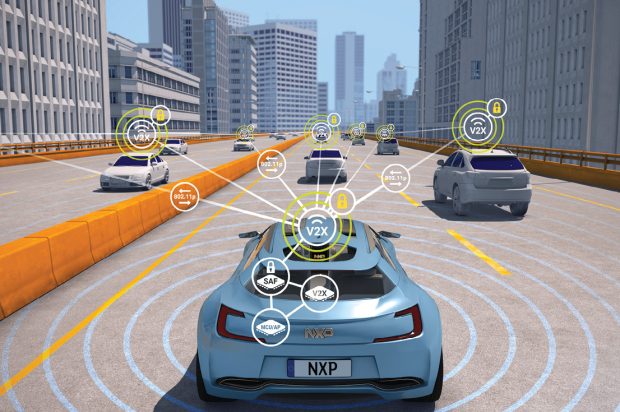 DSRC aims to provide a dedicated secure safety channel for secure communication of safety messages and transportation data in real time. An example of this technology can be seen in NXP Semiconductors’ next-generation RoadLINK, the SAF5400. Image courtesy of NXP Semiconductors.
DSRC aims to provide a dedicated secure safety channel for secure communication of safety messages and transportation data in real time. An example of this technology can be seen in NXP Semiconductors’ next-generation RoadLINK, the SAF5400. Image courtesy of NXP Semiconductors.Essentially, V2X allows vehicles to communicate with all elements of the traffic system around them. This includes other vehicles, pedestrians, associated cloud servers and components of the highway system. The latter category encompasses traffic cameras and lights, lane markers, streetlights and parking meters, for example. When fully implemented, V2X connectivity promises to enable the sharing of a broad spectrum of information, ranging from speed, direction of travel and braking and turning status to road conditions, weather and traffic status.
To complicate this already complex application, V2X communications involve multiple users across various scenarios. To be successful, the system must provide information to the vehicle that is relevant, accurate and cannot be acquired by a single user in any other way. Such information might include data about vehicles that are out of sight (e.g., around a corner) or information located on servers in the cloud (e.g., traffic information, ADAS HD maps or car telematics).
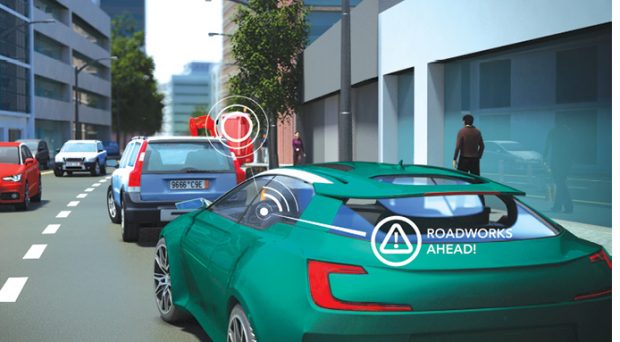 DSRC can work with vehicle-to-infrastructure technology to warn the driver of road construction and hazards not immediately visible to enhance driving safety. Image courtesy of NXP Semiconductors.
DSRC can work with vehicle-to-infrastructure technology to warn the driver of road construction and hazards not immediately visible to enhance driving safety. Image courtesy of NXP Semiconductors.V2X communications interoperability is critical. Vehicles travel over large geographical areas, cutting across local and international boundaries. To deliver on the promise of V2X, these communications must operate without interruptions, even when they cross borders.
In addition to these requirements, whichever communications technology the industry selects for V2X must offer an evolutionary path to meet future demands. “Wireless vehicular technology must have simple mechanisms for evolving the technology, including the possibility of remotely reconfiguring the devices, updating device firmware and turning them off to phase out the technology when the time comes,” says Ali Zaidi, strategic product manager, IoT and broadband, for Ericsson.
The comprehensive nature of the connectivity may seem daunting, but the ultimate challenge is the operating environment. “V2X technology must operate robustly in a very dynamic environment, with high relative speeds between transmitters and receivers, and support the extremely low latency of the safety-related applications in fast highways, crowded urban intersections and tunnels,” says Rob Hoeben, senior director of V2X segment, automotive, NXP Semiconductors.
A Look at DSRC
The current technology, DSRC, has 75 MHz of allotted bandwidth, operating in one of seven 10-MHz channels in the 5.850 to 5.925 GHz segment of the spectrum. To enable traffic systemwide communications, the protocol uses variants of the Wi-Fi standards as the physical and medium access layers of its protocol stack. To optimize the technology for the cluttered, fast-moving automotive environment, the standards use orthogonal frequency-division multiplexing as a means of overcoming frequency selective fading, shadowing and high-speed hand-over difficulties.
The 802.11p standard accelerates data exchange by reducing the initial handshake and association period to a bare minimum. As a result, the protocol can transmit data almost immediately by deferring authentication, encryption and full identification to higher-level protocols. With this boost, transmitters can exchange essential data, such as speed and position information, within milliseconds of detecting each other, providing the communication speed required to enable applications like collision avoidance.
These combined factors enable DSRC systems to communicate effectively among fast-moving vehicles over distances of at least 300 meters, at data rates ranging from 3 to 27 Mbps. In addition, DSRC reduces communication latency to 2 ms.
The protocol uses the IEEE 1609.2 standard to provide for authentication and optional encryption based on digital signatures and certificates. To ensure security, the certificates do not contain information about the driver, and the system changes certificates frequently, making it difficult to track vehicles.
DSRC promises to extend vehicle situational awareness beyond what is currently provided by onboard sensor systems—which are limited by their line of sight—by leveraging vehicle-to-infrastructure connectivity. This means DSRC-enabled vehicles can enjoy 360°, non-line-of-sight awareness.
DSRC: Pros and Cons
Introduced over 10 years ago, industry engineers have attempted to tailor DSRC for safety-critical ADAS applications, as well as to position it to support emerging autonomous driving systems. The long development period has given developers of DSRC and supporting products time to work out the technology’s drawbacks.
“DSRC technology has been standardized, implemented and thoroughly tested,” says Hoeben. “Large investments are being made to guarantee the quality and reliability of DSRC, and several semiconductor companies have designed and tested automotive-qualified DSRC-compliant products. Many hardware and software products are available from multiple suppliers, comprising a rich ecosystem. Finally, there are several car models on the market with DSRC technology, while others are planned to be launched soon.”
Others, however, see the technology’s maturity as a drawback. “DSRC uses an old standard—IEEE 802.11p—which is 10 years old and is based on IEEE 802.11a, which is almost 20 years old,” says Zaidi. “As such, the technology does not include most of the key advancements in wireless communications that have taken place over the past two decades. Moreover, the standard is closed and cannot be modified or enhanced in a simple way—preserving backwards compatibility and allowing forward compatibility for adding new features.”
Detractors of the technology also contend that DSRC is a specific-purpose technology with no application besides vehicle-to-vehicle communication or vehicle-to-roadside-infrastructure. As such, they assert, it has limited use and requires the installation of additional communications equipment, making it more costly to deploy and operate than other alternatives.
Along the same lines, detractors see the integration of 802.11p into handsets for pedestrian and cyclist safety as a major hurdle. They claim that for several technical reasons, widespread Wi-Fi chipsets cannot support 802.11p. To do so, they say, a handset manufacturer would have to incorporate a separate, specially built 802.11p chip in addition to its Wi-Fi chip, a move that they contend would be costly and constitute a significant deployment barrier.
Additionally, critics see DSRC providing limited functionality. “DSRC/802.11p is only addressing basic safety services and has no plans to be further developed to support advanced safety features, including ADAS and automated vehicles, so-called day 2/3 services,” says Maxime Flament, chief technology officer of the 5G Automotive Association.
And Then There’s C-V2X
The challenger to DSRC for V2X emerged from the cellular industry, tailored to complement and extend mobile network capabilities. Currently named C-V2X, the standard was initially introduced as LTE-V2X by the mobile communications standards body, the 3rd Generation Partnership Project (3GPP), in its 3GPP Release 14. The name change reflects the promise that C-V2X will provide an upgrade path from LTE to the 5G mobile standard.
C-V2X offers two transmission modes. One provides direct communications between vehicles, highway infrastructure and other road users. In this mode, C-V2X uses the 5.9 GHz frequency band—also known as the intelligent transport system spectrum (ITS)—and operates independently of cellular networks.
Using direct communications, C-V2X can support low-latency connections over short distances. As with 802.11p, C-V2X leverages the global navigation satellite system to determine a vehicle’s position and to synchronize communications between vehicles and the roadside infrastructure. This mode does not require a subscriber identity module (SIM) card because the vehicle does not connect with the cellular network. The network-autonomous operation also protects the driver’s privacy because no cellular subscription is required.
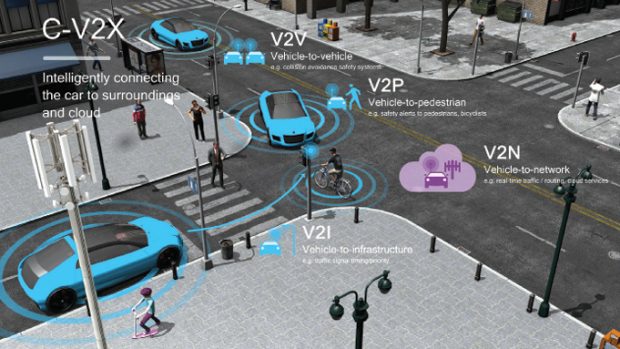 C-V2X encompasses two transmission modes: direct communications and network-based communications. Combined, these support key features of safe driving and autonomous driving systems, complementing Advanced Driver Assistance Systems sensors to provide enhanced situational awareness. Image courtesy of Qualcomm.
C-V2X encompasses two transmission modes: direct communications and network-based communications. Combined, these support key features of safe driving and autonomous driving systems, complementing Advanced Driver Assistance Systems sensors to provide enhanced situational awareness. Image courtesy of Qualcomm.C-V2X can co-exist with 802.11p in the 5.9 GHz frequency band by using different channels. The cellular–based systems require only 10 MHz of spectrum to support basic safety services. On the other hand, 70 MHz enables the systems to support advanced safety services, opening the door for sharing large amounts of data collected by on-vehicle sensors.
The second mode operates in mobile operators spectrum band, using the conventional mobile network to enable vehicles to receive information from the cloud regarding road and traffic conditions in the area.
C-V2X can combine the capabilities of the cellular network and radio base stations called roadside units (RSUs) to improve safety services and support autonomous driving. RSUs reside at intersections or along the side of the road (e.g., on lamp poles and traffic light poles), enabling communications between vehicles and the highway infrastructure within a localized area. Designers see these RSUs leveraging high-throughput connections with other cars to build local, dynamic, high-definition maps, using camera and sensor data.
Moving forward, C-V2X release 15—which 3GPP expects to complete this month—will augment current technology by incorporating 5G New Radio features. These will include higher-throughput, wideband carrier support for sensor data from surround cameras, radar, lidar and other car sensors, enabling map sharing among vehicles or even streaming video from one car to another. Experts expect release 15 will maintain backward-compatibility with previous C-V2X releases.
Although these improvements have yet to be delivered, early tests have shown that current C-V2X data rates fall within a range comparable to DSRC’s 300 m at urban driving speeds. Furthermore, test data seems to indicate that C-V2X achieves 20% to 30% better range at faster speeds.
C-V2X’s Pros and Cons
Many perceived advantages of C-V2X stem from the technology’s cellular base. For example, proponents assert that their systems benefit from being based on technology intended for high-speed mobile applications, pointing to test results that indicate C-V2X outperforms 802.11p in areas like alert latency and range. They also say that C-V2X can leverage all features provided by the existing cellular LTE network.
Not all parties, however, agree with this last claim. “C-V2X is a relatively new extension of cellular 4G/LTE,” says Hoeben. “As a result, certain key features are not mature, and will only be partially corrected in the next release [Rel-15].”
Perhaps its greatest strength is that C-V2X casts a broad connectivity net, offering direct and network-based communications. As a result, vehicles can not only connect with other vehicles, but also with other traffic-system elements that incorporate cellular technology, such as cloud-based assets, pedestrians and cyclists with smartphones. Furthermore, advocates of C-V2X contend that 5G-based C-V2X will be a key step toward autonomous cars because it can help cars detect obstructions that aren’t visible to the driver.
The cellular technology also promises cost advantages. “C-V2X is the only V2X technology positioned to be integrated into the cellular modems that carmakers plan to embed into most production vehicles—driving adoption in support of—or even in the absence of—a regulatory mandate,” says Nakul Duggal, vice president of product management, automotive, for Qualcomm Technologies.
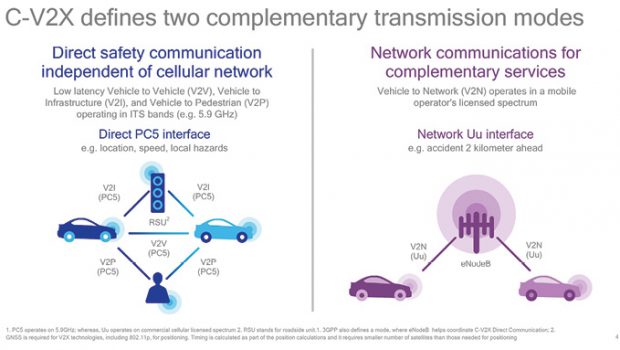 C-V2X technology aims to complement other vehicle sensor technologies by extending a vehicle’s ability to “see” further down the road, tapping into information gleaned from other vehicles, highway infrastructure, pedestrians and network sources. Image courtesy of Qualcomm.
C-V2X technology aims to complement other vehicle sensor technologies by extending a vehicle’s ability to “see” further down the road, tapping into information gleaned from other vehicles, highway infrastructure, pedestrians and network sources. Image courtesy of Qualcomm.“Reduced infrastructure deployment cost is another key benefit of C-V2X, from the potential to reuse existing mobile infrastructure, and thus leveraging cellular technology integration and economies of scale rather than building independently operated roadside infrastructure,” he adds.
Cost advantage claims also seem to be supported by promises of greater energy efficiency. “Unlike 802.11p devices, 3GPP Rel-14–compliant chipsets allow resource selection based on a power-efficient sensing scheme—partial sensing,” says Flament. “With the partial sensing, the UE senses on the radio channel within the configured time window only, rather than the less predictable nature of carrier sense multiple access (CSMA) in 802.11p, where the clear channel assessment algorithm can require the receiver to be active frequently. Studies in 3GPP show that the partial sensing can provide similar radio performance—packet reception ratio—at the cost of much lower power consumption compared with the frequent medium sensing required in CSMA. Therefore, partial sensing would balance the radio performance and UE battery consumption for UE devices that have limited battery capacity.”
Although the performance advantages claimed by C-V2X proponents have caught the attention of many in the industry, some nagging doubts remain, such as the fact that C-V2X hasn’t been as extensively tested and vetted as DSRC. That said, trials are ongoing, and chips and modules are becoming available.
The Outcome?
The competition between DSRC and C-V2X continues. No decision has been made. The momentum, however, seems to be moving toward a C-V2X outcome. Cellular carriers and some semiconductor companies like Qualcomm are pushing hard for C-V2X. Now some of the carmakers previously committed to DSRC have switched sides. Furthermore, the advocacy organization 5GAA—with over 75 corporate members, leading auto manufacturers and high-tech giants like Intel—has thrown its weight behind the C-V2X agenda.
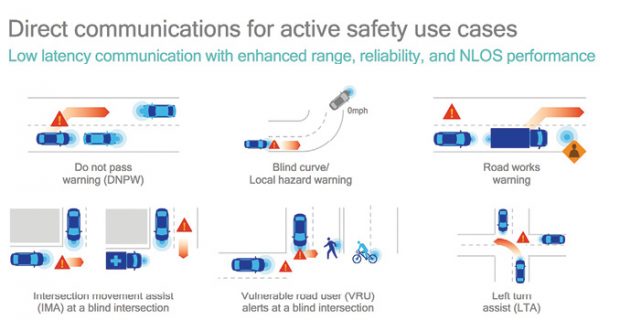 The foundation of the C-V2X is the direct transmission mode, which allows cars to communicate directly with each other, without relying on cellular networks or base stations for communication. Image courtesy of Qualcomm.
The foundation of the C-V2X is the direct transmission mode, which allows cars to communicate directly with each other, without relying on cellular networks or base stations for communication. Image courtesy of Qualcomm.Advocates of DSRC, however, have shown no signs of giving up the fight for V2X dominance. In fact, the IEEE has begun a study group to update the 802.11p standard, with an eye toward improving its capabilities in V2X applications.
Another factor to consider is that standardizing on C-V2X would probably mean further delays. The relevant U.S. government agencies could require years of testing. This timetable would in all likelihood be unacceptable to the auto industry, given its desire to move forward with projects like ADAS and autonomous cars.
Perhaps another perspective is called for. “The best way forward to decrease road fatalities and increase road safety is a hybrid communication approach in which DSRC [5.9 GHz] and 5G cellular [3.x GHz] technologies work together,” says Hoeben.
Subscribe to our FREE magazine, FREE email newsletters or both!





